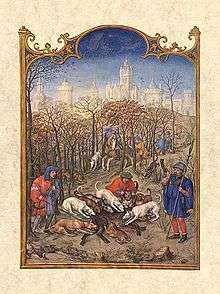Gerard Horenbout
Gerard Horenbout (c. 1465–c. 1541) was a Flemish miniaturist, a late example of the miniature tradition in Early Netherlandish painting. He is "likely and widely accepted" to be the Master of James IV of Scotland.[1][2]


Biography
Horenbout lived and worked in Ghent and is best known as a manuscript illustrator. He also made stained glass, tapestries, embroidery designs, ironworks and panel painting. First mentioned in 1487, when he joined the painters Guild of Saint Luke.[1][3] He was married to Margaret Svanders soon after joining the guild. They had six children, two of whom were the artists Lucas Horenbout and Susanna Hornebolt. There were also sons Eloy and Joris. Lucas, Susanna and at least one more of his sons were trained by Horenbout to be painters.[1]
He had at least two apprentices, one in 1498, and one in 1502. In 1515, he was made painter to Archduchess Margaret of Austria, and also briefly worked at the court of Henry VIII in England. He was visited by Albrecht Dürer in 1521, when Dürer bought an illustrated manuscript made by his daughter Susanna Horenbout. His son Lucas Horenbout was also a well-known painter.[3]
His wife, Margaret Svanders, or van Saunders, died in 1529[4][5] and he made the brass plaque found at All Saint's Church in Fulham, London.[6][7][nb 1]
He died about 1540 or 1541.[1]
Works
- Miniatures in the Breviary of Eleanor of Portugal, ca. 1500
- Miniatures in the Hours of James IV of Scotland, between 1502 and 1503[8]
- 16 miniatures in the Sforza Hours for Archduchess Margaret of Austria, between 1517 and 1520 (now in the British Library)[9]
- Miniatures in the Grimani Breviary, before 1520[10]
- Portraits of Lieven Van Pottelsberghe and Livina Van Steelant, c. 1525, in the Museum of Fine Arts, Ghent
Notes
- It is described as a memorial to "Margaret (Saunders), wife of Gerard Hornebolt, c. 1529, lozenge-shaped plate with head and shoulders of woman in shroud, and angels on each side above inscription, below a shield-of-arms, a cheveron between three martlets with an escutcheon on the cheveron charged with a mill-rind cross between four crescents for Hornebolt impaling a winnowing-fan with a molet of six points in chief for des Vanders quartering a cheveron between three moors' heads for Deman, between initials G.M. Flemish work."[6]
References
- Susan E. James. The Feminine Dynamic in English Art, 1485-1603: Women As Consumers, Patrons and Painters. Ashgate Publishing Company; 2009. ISBN 978-0-7546-6381-2. p. 242.
- Scot McKendrick. "Reviving the Past," in Illuminating the Renaissance: The Flemish Triumph of Manuscript Painting in Europe. Getty Publications; 1 July 2003. ISBN 978-0-89236-704-7. p. 428.
- Richardson, Carol M.; Woods, Kim (2007). Renaissance art reconsidered: an anthology of primary sources. Michael W. Franklin. Wiley-Blackwell. pp. 10–11. ISBN 978-1-4051-4641-8. Retrieved 8 July 2009.
- Kathy Lynn Emerson, Wives and Daughters: The Women of Sixteenth Century England. Troy, NY: Whitston, 1984. p. 113.
- James Thorne. Handbook to the Environs of London: Alphabetically Arranged, Containing an Account of Every Town and Village, and of All Places of Interest, Within a Circle of Twenty Miles Round London. John Murray; 1876. p. 220.
- Fulham: Parish Church of All Saints. An Inventory of the Historical Monuments in London, Volume 2: West London (1925), pp. 31-37. Retrieved 29 January 2014.
- Susan E. James. The Feminine Dynamic in English Art, 1485-1603: Women As Consumers, Patrons and Painters. Ashgate Publishing Company; 2009. ISBN 978-0-7546-6381-2. pp. 242-243.
- Hellinga, Lotte; Trapp, Joseph Burney (1999). The Cambridge History of the Book in Britain: 1400-1557. Donald Francis McKenzie, David McKitterick, John Barnard, Ian R.. Willison. Cambridge University Press. p. 56. ISBN 978-0-521-57346-7. Retrieved 8 July 2009.
- "High quality version of the Sforza Hours". British Library. Archived from the original on 25 May 2009. Retrieved 8 July 2009.
- Wolf, Norbert (2004). Hans Holbein the Younger, 1497/98-1543: the German Raphael. Taschen. p. 48. ISBN 978-3-8228-3167-0. Retrieved 8 July 2009.
| Wikimedia Commons has media related to Gerard Horenbout. |